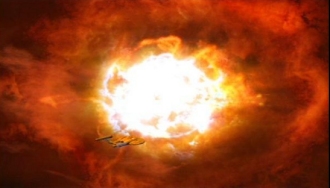
Precise definitions vary, but all astronomers agree that hypergiants are the most massive and luminous type of star in space. They can have masses of up to about 100-150 solar masses and can be up to 40 million times more luminous than the sun. One such hypergiant was encountered in the Star Trek: Enterprise episode "Cogenitor", when the Enterprise NX-01 became the first Earth ship to research a red hypergiant at close range. It was nearly a billion kilometers in circumference and was not expected to go supernova for another one hundred or two hundred years.
TIn reality, hypergiants are indeed very unstable and because of their high masses, the lifetime of a hypergiant is very short in astronomical timescales. They survive for only a few million years (compared to around 10 billion years for stars like the Sun) before exploding as supernovae and leaving behind black holes. Because of this, hypergiants are extremely rare. With a radius of about 1800 to 2100 times that of the Sun, VY Canis Majoris (VY CMa) is the largest known star and also one of the most luminous known. A red hypergiant star located in the constellation Canis Major, it is located about 1.5 kiloparsecs (4,900 light years) away from Earth.
Only about a dozen others are known in our galaxy, including Eta Carinae, P Cygni, and Rho Cassiopeiae. S Doradus is a hypergiant in the nearby Large Magellanic Cloud.


The hypergiant encountered in Star Trek: Enterprise.

VY Canis Majoris, the largest known star, is
surrounded by clouds of material ejected by the star.